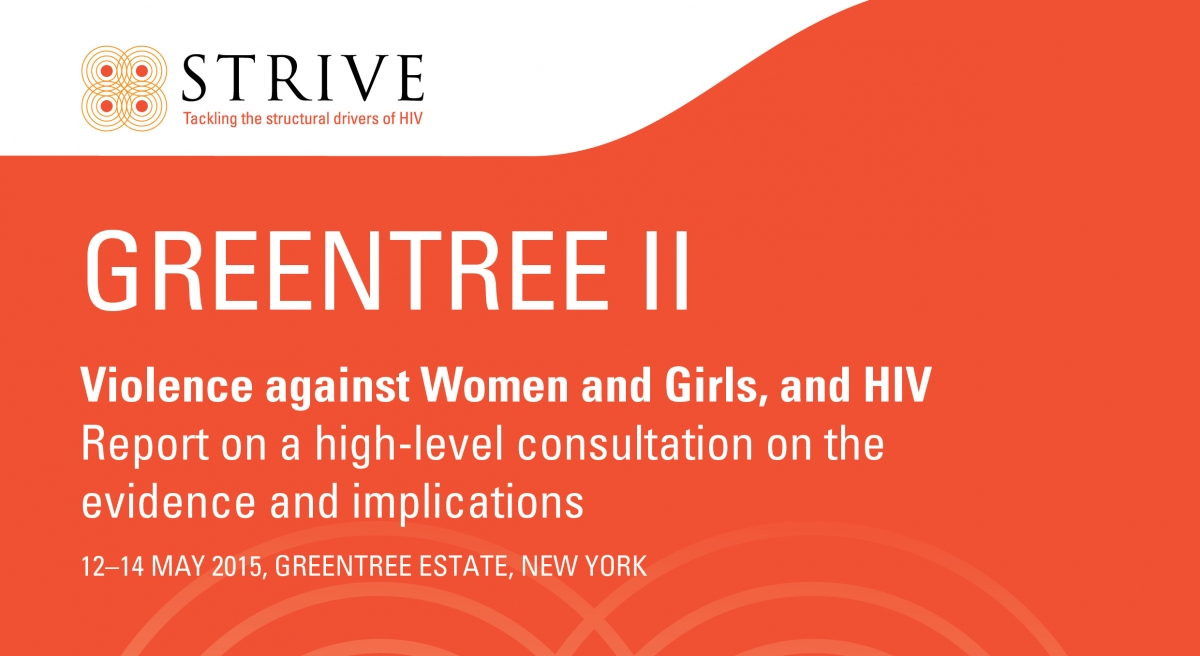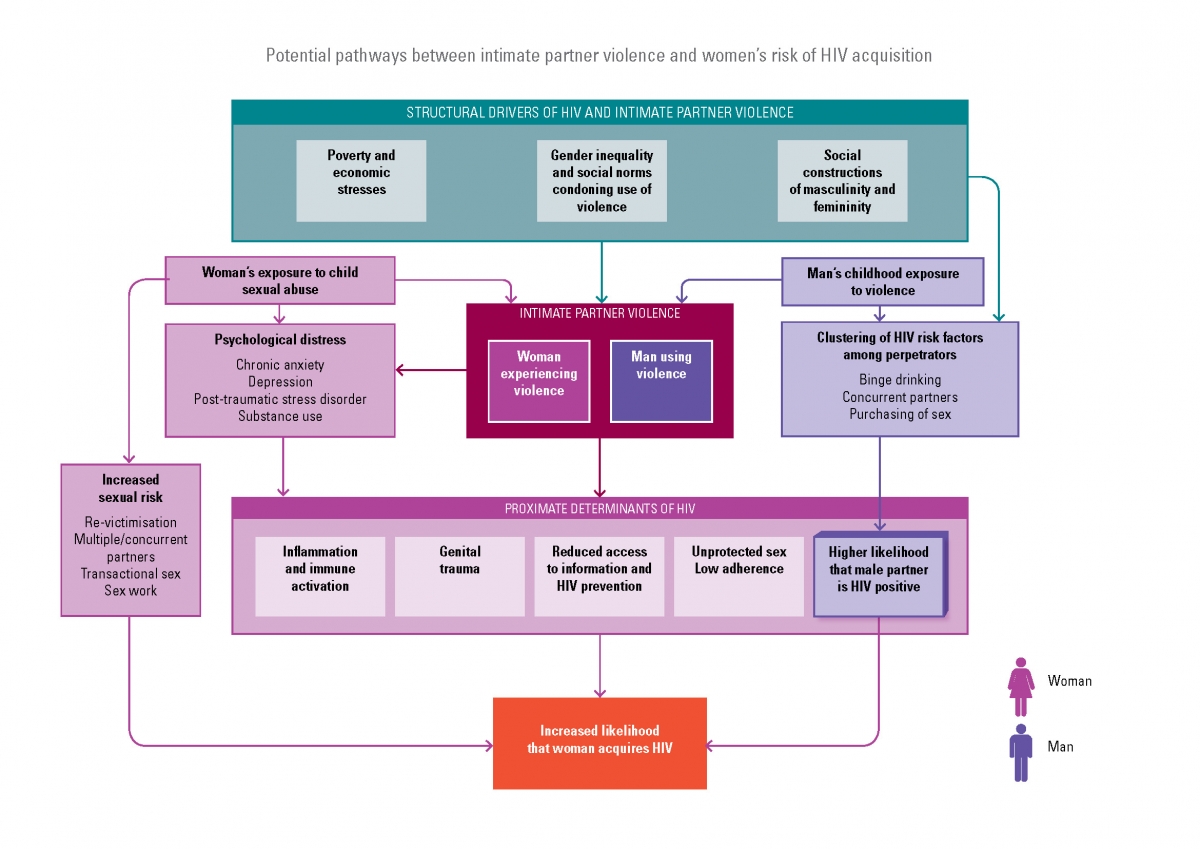
Compiled and edited by Lori Heise and Elizabeth McGrory, this publication synthesises the discussions and conclusions of a three-day expert consultation on the links between HIV and violence against women and girls (VAWG).
STRIVE convened the consultation with support from WHO, UNICEF, UNAIDS and the Greentree Foundation in order to:
- examine the existing evidence base on the links between VAWG and HIV and identify critical knowledge gaps
- develop a conceptual model that captures the potential pathways through which violence influences HIV-related outcomes
- propose a research agenda to resolve outstanding questions
- suggest priority actions for policy, programmes and research
Greentree II took place against a backdrop of heightened concern about risk of infection among young women, especially in sub-Saharan Africa. The gathering built on a prior meeting (Greentree I, March 2012) that explored the physiology of sexual violence and its role in HIV transmission and acquisition. The report from the 2012 Greentree consultation clarified the role that genital trauma and forced sex play in facilitating HIV acquisition, especially among young women. Greentree II was convened in 2015 to deepen and share this evidence, as well as examining the broader structural and social factors that affect the association between HIV and VAWG.

Evidence
As detailed in the report, the diverse set of policymakers, clinical, epidemiological and social science experts and programme implementers at Greentree II reached a range of conclusions that are important for the field.
- There is growing evidence that violence in all of its forms – physical, sexual and verbal – potentiates susceptibility to HIV and disease progression among women and girls. Violence and trauma can lead to lower CD4 counts, higher viral loads and lower adherence to prevention and treatment. Addressing violence against women and girls, especially by intimate partners, is essential to achieving the UNAIDS 90-90-90 treatment targets by 2020 and to ending the HIV epidemic by 2030.
- Violence is a manifestation of the structural social and economic inequalities between men and women, at the same time as it further exacerbates these inequalities.
- The health and social effects of violence against women and girls are cumulative and long-term. Adolescents and young women are especially at risk, due to a combination of enhanced biological susceptibility to HIV acquisition and developmental vulnerabilities.
- The HIV epidemic in sub-Saharan Africa cannot be brought under control without reducing HIV acquisition among adolescent girls and young women, the most rapidly expanding demographic group on the continent. Given the association between violence and HIV acquisition in young women, addressing violence against women and girls is critical to curbing the HIV epidemic overall.
What do HIV planners and donors need to know?
From this new synthesis of evidence, Greentree II participants proposed priorities for attention.
- The background rates of violence in the lives of women and girls in many HIV hotspots are extremely high. For example, in many countries in Africa, more than one third of women have been beaten by a partner in the past 12 months. Women also experience high rates of verbal and psychological violence.
- Women living with HIV also experience heightened levels of violence, including a high rate of violence associated with a woman disclosing her HIV status to her partner. Violence poses a substantial barrier to the effectiveness of existing HIV strategies, undermining the uptake and adherence to proven biomedical prevention and treatment options.
- Three well-designed longitudinal studies from Africa, together with supporting evidence from numerous cross-sectional surveys, confirm that women’s experience of intimate partner violence is associated with a 50% increase in the risk of HIV acquisition.
- Contrary to popular belief, sexual violence appears NOT to be the main factor explaining the association between violence and HIV at a population level. Although individual women can become infected with HIV through rape or forced sex, a number of indirect pathways appear to be far more significant.
- One pathway is sexual abuse in childhood, which sets up a cascade of developmental and psychological consequences that can lead to a range of risk behaviours – such as earlier sexual debut, more sexual partners and substance use – that increase a woman’s risk of both acquiring HIV and of being re-victimised by violence in adulthood.
- A second important factor is the HIV status of a woman’s sexual partners. It is now clear that men and boys who abuse women and girls are themselves more likely to be HIV+, which in turn increases risk of HIV acquisition among their partners. Men who are violent are also more likely to engage in a range of risk behaviours, including having outside sexual partners, abusing alcohol and other substances, engaging in anal sex and visiting sex workers.
- Finally, emerging evidence suggests that violence and trauma have a biological effect on immune and hormonal functions believed to be important in potentiating HIV acquisition and disease progression. Thus, women living in abusive relationships or violent settings may be biologically more at risk of acquiring HIV, and possibly of HIV progressing more rapidly.
- In conflict settings, sexual violence perpetrated by combatants may not be the main risk of violence or of any concomitant HIV transmission. Prevalence of household and intimate partner violence is often high in conflict, disaster and humanitarian contexts.
- Programmes and interventions have been shown to be effective in reducing violence, improving HIV outcomes and benefiting other areas of women’s health and social well being such as education, poverty and mental health. Some also have the potential to be cost saving. Several proven programme models, including community-based programmes implemented in Rwanda and Uganda, have been evaluated with rigorous cluster randomized trials.

Watch a short video, in which three participants outline the significance of the Greentree II meeting.



